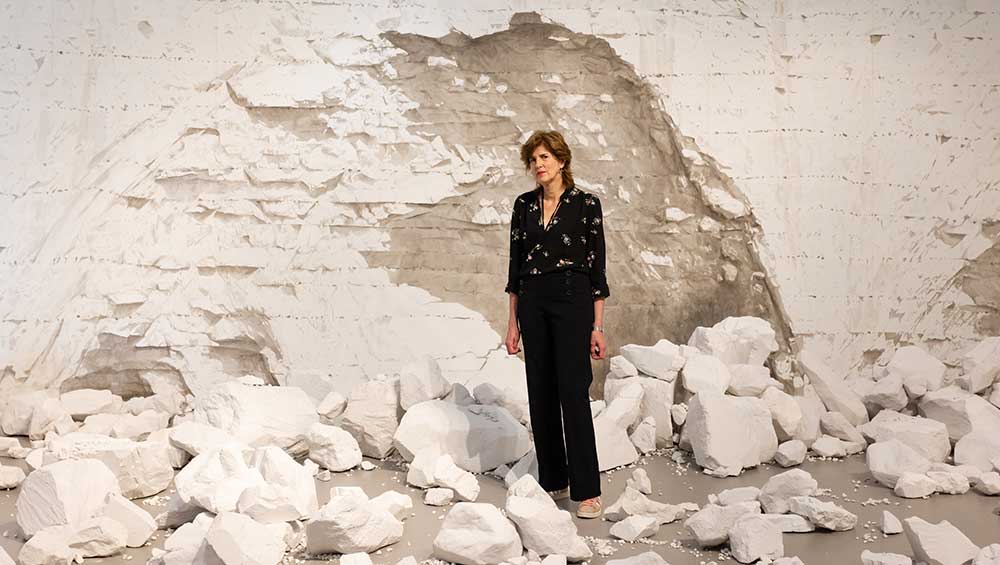
Emma Stibbon. Photo: Rob Harris.
by VERONICA SIMPSON
There is a spectacular moment in Emma Stibbon’s (b1962, Münster, Germany) Towner show, as you enter the main gallery: a crumbling, chalky Sussex cliff is brought crashing into your consciousness, literally, thanks to the huge lumps of simulated chalk rock and smaller, scattered pieces of real chalk, combined with Stibbon’s impressive wall drawing, Cliff Fall. It’s a stunning drawing both in scale and technique, filling the whole wall. Stibbon uses real Sussex chalk in the mix and brings a compelling, three-dimensional sensibility to her execution of the “wave-cut” indentation along the base of this local landmark. These “wave cuts” are where the repeated actions of the waves, over the ages, turn cliff face into cave; thus rendering treacherous the seemingly solid ground far above them.
The whole show is a profound meditation on erosion, on bearing witness to the impact of climate warming on landscapes both here in East Sussex, but also in the Arctic and Antarctic regions where Stibbon has been making regular pilgrimages for the past two decades.
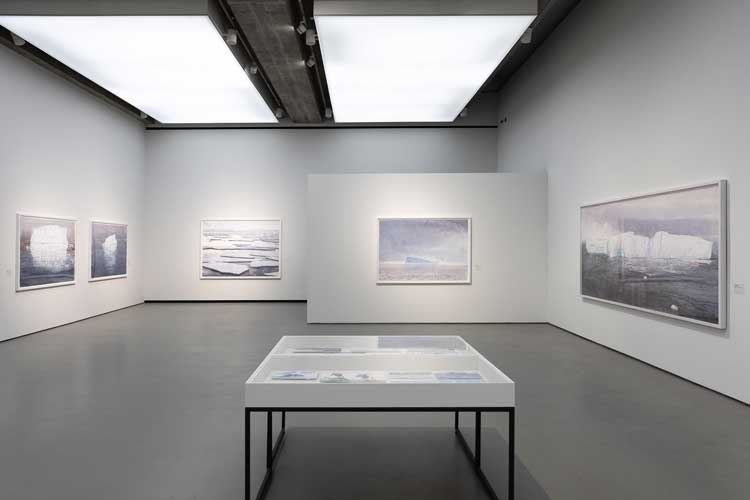
Emma Stibbon: Melting Ice | Rising Tides, installation view, Towner Eastbourne, 2024. Photo: Rob Harris.
You may not think that coastal erosion in the temperate, charming chalklands of Sussex and the melting of glaciers have much in common, but this show, and its expert curation, really brings those connections home. The whole top floor of the Towner – usually subdivided into three, as for its recent Turner Prize exhibition – has been opened up, with the visitor arriving at the centre, in a small foyer space, to encounter a partial wall, bearing the title of the show: Melting Ice / Rising Tides in bold black type, against a bright-yellow pattern that cleverly incorporates qualities of geological mapping as well as melting water (the hazard colouring of black on yellow, she tells us, is intentional). A few chalk rocks peek alluringly from the room beyond. To the right in this foyer is one of Stibbon’s Sussex drawings, poetically titled Hope Gap (2022): the name of a local metal staircase which usually ushers walkers down the cliff to the beach, but which has been out of bounds since last summer, as the lower steps are now submerged during high tides. We feel the magnetic pull of the waves circling around its base.
-Pic-V-Simpson.jpg)
Emma Stibbon. Hope Gap, 2022 (detail). Ink and sea salt, 225 x 141 cm. Installation view, Towner Eastbourne, 2024. Photo: Veronica Simpson.
Rounding the partial entrance wall we meet the Cliff Fall installation (2023), facing a massive drawing of a Sussex wave – Breaker (2023) – which reveals the granular effects of the Sussex seawater Stibbon infused into her ink mixture.
In the left-hand gallery, Stibbon has curated a few treasured prints and paintings from Towner’s extensive collection, as well as historic postcards from the past 100 years, with companion drawings of her own revealing, on walls and in showcases, how these landscapes have changed.
In the right-hand gallery, drawings of icebergs almost levitate off the walls, adding ethereal hints of pinks, lilacs and bluey greys to the otherwise largely monochrome presentation – there’s even a scattering of aluminium dust across one of her ice cliff drawings to bring a realistic snow-encrusted dazzle. Stibbon’s intention is to really immerse the viewer in these landscapes, bringing home not just how real and present the dangers of climate change are but the beauty of the natural world around us.
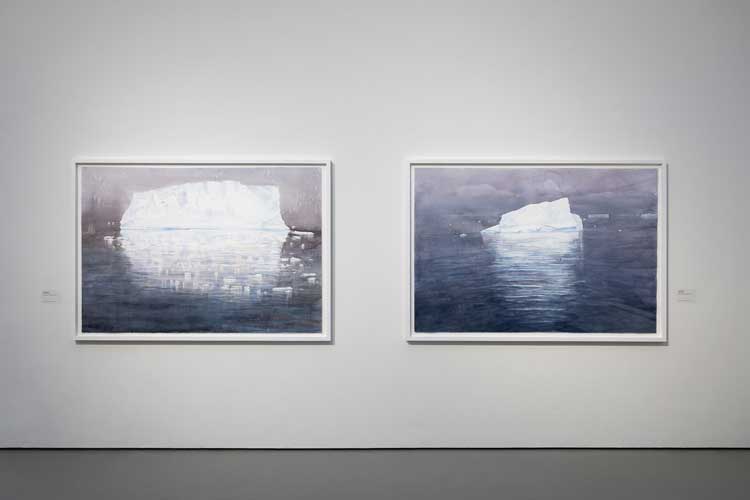
Two large scale iceberg drawings from 2023. Installation view, Emma Stibbon: Melting Ice | Rising Tides, Towner Eastbourne, 2024. Photo: Rob Harris.
Stibbon says: “I wanted the show to have a visual beauty. My work has a melancholy to it, but I don’t want to be presenting a doomsday situation.” There are useful conversations around context and engagement in the film that is screened to the rear of the third gallery, featuring local Green party MP Caroline Lucas and the Environment Agency who present ambitious, 100-year plans for mitigating against coastal erosion.
Stibbon studied for her fine art BA at Goldsmiths, University of London and has an MA in research fine art from the University of the West of England, Bristol. She is represented by the London gallery Cristea Roberts. She was made a member of the Royal Academy in 2013 and has exhibited in group and solo exhibitions internationally, with her work held in numerous private and public collections, including the Stadtmuseum, Berlin, the Victoria and Albert Museum, London, and the Royal Academy of Arts, London. She lives and works in Bristol.
We spoke to the artist in person at Towner Eastbourne.
Veronica Simpson: When were you first drawn to the idea of visiting the Arctic and Antarctic, and how were those first visits made possible?
Emma Stibbon: The first trip was, I think, in 2003 – over 20 years ago. It was extraordinary. It immediately seemed to clarify my vision of what I was doing with other aspects of my work. Seeing this white continent of ice, it challenged the way I was working in terms of media, which up until then had been tonally dark. And then I had an opportunity to go to the Arctic, to Svalbard. I had been looking for a long time at glaciers – another natural feature or phenomenon that preoccupied me. The fascination was at first visual, but, increasingly, on repeat visits to glaciers and alpine glaciers, I started to notice that things were retreating fast. And the Mer de Glace in Chamonix was quite significantly retreating, even within an eight-year period between visits. I started to realise, alongside the science and data, that climate warming is affecting the planet. That was the focus. As an artist who works from landscape, that concern became something I wanted to commit to.
VS: What sort of work were you doing before that?
ES: I think my work is rooted in British landscape tradition, the romantic sublime, problematic though that is, and the idea of being overwhelmed by nature and the traditional notions of the sublime being of awe and wonder. If we bring that into our contemporary times, we’re in a different situation. In those early representations from the 18th and 19th century, the viewer would traditionally be seated on a rock or outside the frame looking at that spectacle, whereas now we’re really in that frame. I want to bring the viewer into the landscape.
-6.jpg)
Emma Stibbon. Cliff Fall, 2023. Acrylic on gesso prepared board with chalk rocks and mixed media, 500 x 781.4 x 800 cm, installation view, Towner Eastbourne, 2024. Photo: Rob Harris.
VS: You have been able to really immerse us in the landscape at your show at Towner Eastbourne, with the installation Cliff Fall. Is working on that scale unusual for you?
ES: Towner commissioned me to do a work, and they have big spaces. I had made a piece in another space to do with a forest fire which had a three-dimensional element. But for this show I thought I could try and evoke the sense of walking under the cliffs of that Sussex coastline around Seven Sisters, with the immensity of those chalky cliffs towering above you. I have taken the central gallery’s main wall, which is about 8m wide by 5m high, and drawn a kind of undercliff like there is along the Seven Sisters. In fact, I had visited the particular feature I have drawn, going along the cliffs in a small boat, and seen these wave-cut notches, where a wave action notches out a rock, and that then, over time, becomes a cave, and then that collapses and you lose the cliff. This is something you’re completely unaware of when you’re walking along the top of Seven Sisters and thinking you’re on solid ground. But I was fascinated by these hollowed out absences of rock. From that feature I have projected into the gallery space a three-dimensional rock form. We have some fabricated rocks and some locally sourced chalk. And that spreads on to the gallery floor, and the,n as you turn around, on the facing wall, I have made a large drawing of a big wave coming towards you, so you’re almost trapped between the sea and the rocks. In terms of scale, it is big, and it’s been quite a major undertaking. The Cliff Fall drawing itself I had to do on a set-painting screen at the Old Vic Theatre in Bristol.
That sense of close encounter is important: I want to suggest that we’re in this situation now, which has happened in our lifetime, and it is urgent, the most pressing concern of our times.
VS: I would like to delve into the impact on you of actually visiting these environments. There is a short video interview with you on the Royal Academy website, where you talk about being on an ice breaker and seeing the prow of the ship create an extraordinary pathway as it cuts through the ice. I can imagine how thrilling that is. But it seems a big leap to me to want to actually go out there and encounter those hostile environments for yourself.
ES: If I look back through my career, it has always been rooted in being out there. Even though the bulk of the work is made in the studio, I need that experience of physicality and the visceral impact of being in the place. I draw in my sketchbook in response to what I’m seeing. I see it as fieldwork. I document my time, and there’s a sense of witnessing – when I see what’s happening to the Mer de Glace, it’s an absolute recognition that this (climate change) is happening. I want to record that. Sometimes I am gathering materials to bring back to the studio and use in the work – like the Sussex chalk. When you’re drawing from observation, that challenge of your materials possibly freezing, and the risks and constraints of being in a place – even possible predators like polar bears, in Svalbard – those are all things that feed into the work when you’re drawing; things are freezing or the wind is battering you. It’s not about making finished pieces of work, but it does somehow embed itself into the drawing.
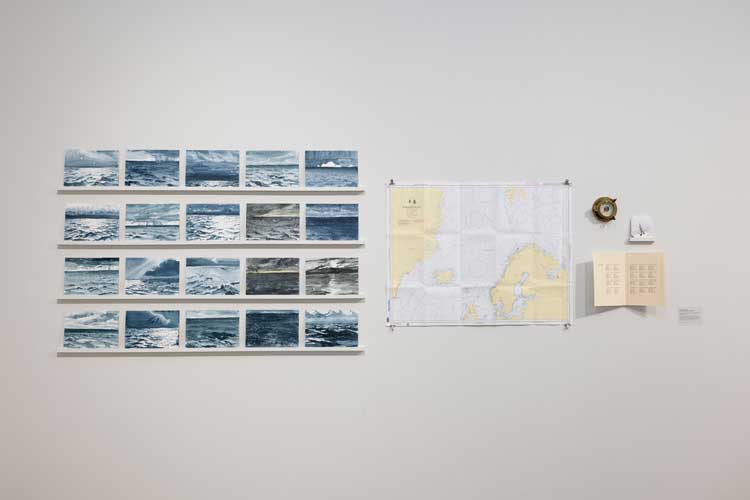
Emma Stibbon: Melting Ice | Rising Tides, installation view, Towner Eastbourne, 2024. Photo: Rob Harris.
VS: Did you see a shift in the work as you encountered those environments – a sense of your physical, visceral response translated on to the page?
ES: I do in the studio. I have a digital camera, and I use that for my larger works. The sketchbook drawings are not necessarily the things I use as references, graphically, but they take you back to the experience of the place, and it’s that deep memory, that physical recall, from drawing and observation, which the work somehow encompasses.
When you’re drawing, the whole panorama of information is overwhelming, but somehow you have to filter that and put it down on a page. I would challenge the idea of it being hostile – it’s cold, it’s difficult, but it’s not necessarily remote or extreme. For me, that adds to the experience. I think it’s more honest to say that, having seen Antarctica, the visual wonder of that continent is extraordinary, the drama of the ice, and graphically that offers a lot visually to my work. It’s the visual combined with an awareness of what’s happening, in particular in Svalbard: it’s the fastest warming place on the planet. That’s a very salutary thing to think about when you are out there, looking at a glacier.
VS: And how have your repeated visits impacted the work?
ES: It has made me think more about representing landscape in terms of time and history. For example, I was commissioned a while back for a big John Ruskin show (Ruskin, Turner and the Storm Cloud, York Art Gallery and Abbot Hall Art Gallery, Kendal, 2019) to make a contemporary response, and I chose the Ruskin daguerreotype of the Mer de Glace. Then I was looking back at Turner’s early watercolours of that region of the glaciers, most of which are pre-photography. It was interesting to me to think of these now as documents – for glaciologists, they are records of where glaciers have been over time. Obviously, technology can now record more accurately than a watercolour. But it’s also a moment in time. The artist is saying: this is what I have seen. Looking back at what I have made, it’s like a record, a monument or a portrait of something. Like the bergs on a recent trip to Antarctica. I made records of some of the bergs we were passing. And I thought of it as something fleeting, I wanted to record it for that day, that moment. Maybe in 200 years they will be gone.
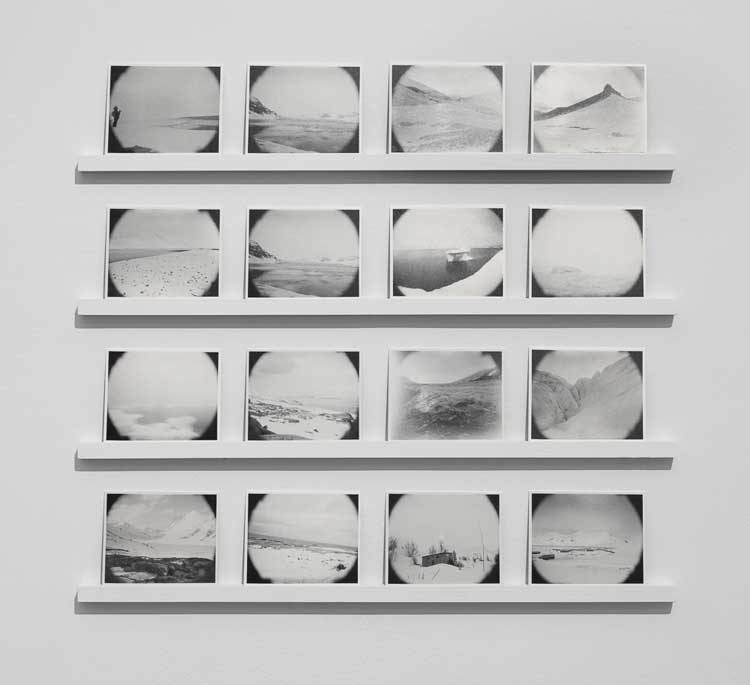
Emma Stibbon: Melting Ice | Rising Tides, installation view, Towner Eastbourne, 2024. Photo: Rob Harris.
VS: How do you get out to these places?
ES: Well, I have been out with the navy, HMS Protector has a residency, as part of a research institute. I have been to Svalbard three times, and the second time it was through a residency. They have an amazing print workshop there (Artica Svalbard). It’s a fantastic, professional print studio, set up by Queen Sonja of Norway, who is a big supporter of the arts.
I have also travelled with the Arctic Circle, an American organisation, which takes artists and writers and scientists out there on board a beautiful wooden sailing boat. I have been twice with them. But it takes time and money to organise getting to these locations.
VS: The trip itself must take ages – up to a month?
ES: The Royal Navy trip took five weeks. And, actually, I’m not a good traveller. I get really anxious, I immediately feel ill the moment I set sail and realise: “There are no hospitals, oh no! I’m going to die!” But there’s also that feeling of, “I’ve got to see this.” And, obviously, I have also got concerns about my carbon footprint, and I have to take some responsibility. When I’m planning, I have to think really hard about how much material will result. But going to Antarctica, that might give me two years of material. It is very much a focused work situation.
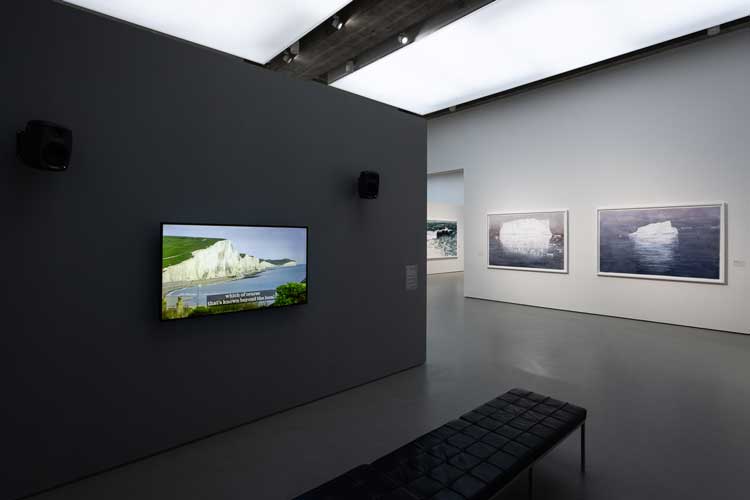
Emma Stibbon: Melting Ice | Rising Tides, installation view, Towner Eastbourne, 2024. Photo: Rob Harris.
VS: How did you approach the commission from Towner? Are you familiar with the East Sussex landscape?
ES: A little. I have been teaching at the University of Brighton – though I have been living in Bristol for over a decade – and sometimes I bring the students here. For the past two or three years, I have been walking the coastline and investigating locations. In places, such as at the Birling Gap, the ground is particularly soft – it’s called coombe rock – so it’s not quite chalk, but it’s an area of rapid erosion. There were eight coastguard cottages there, and now there are only four. Even in my short period of visiting, the National Trust, which runs that stretch, has had to dismantle the café. And another place I have drawn is Hope Gap, which is a lovely robust staircase down to the sea which has been closed to the public since last August because the sea is encroaching. Within just two years I can see the changes. Every time I visit, there is new rockfall.
-22.jpg)
Emma Stibbon. Cafe Demolition, 2024, installation view, Towner Eastbourne, 2024. Photo: Rob Harris.
When Towner invited me to create the show, I wanted to connect that sense of something seemingly remote with the immediate landscape of where Towner is located, on the chalk downlands of East Sussex. It’s a really iconic piece of landscape. And if we’re thinking about how polar ice melt is affecting sea-level rise, that is affecting the British shoreline. Of course, it is affecting other parts of the globe even more dramatically. And our actions are affecting carbon emissions. But it’s not a gloom-and-doom show. I wanted to feature a local Sussex landscape, along this cliff shoreline, which the local visitor would recognise. It’s a dramatic landscape, which has always been a location for holidays, and it’s also very sublime here; that white chalk is amazing, when you’re on it, the light in it. But it’s quite terrifying if you’re standing underneath – which I don’t advise.
Regarding the work, specifically on the big piece, I really wanted an immersive encounter for the viewer. And that seemed to be something that could be three-dimensional and expansive and outside of the frame. I also wanted to use materials from the landscape. Chalk from the cliff face is ground up and goes into the surface of the big drawing. But there are also chalk drawings which are on black paper. I like the fragile surface of chalk, which you could wipe away with your hand, and which somehow equates with the subject being something on the brink of collapse.
-12.jpg)
Emma Stibbon, Breaker, 2023. Ink, sea salt and Eastbourne sea water, 153 x 343.5 cm, installation view, Towner Eastbourne, 2024. Photo: Rob Harris.
On the subject of mediums, I have also used seawater. There’s a big sea drawing, Breaker, done in Indian ink. Oddly, I haven’t tried using seawater before, and the pigments dispersed quite strangely, organising themselves into some other form. One of the galleries features a series of drawings of the sea which I made on the deck of a wooden boat, while we passed from the north of Norway to Svalbard, which took three days and was very rough. I made drawings not intended as a work to exhibit, but it became apparent the further north we got that the ice in the ink was taking over. I had 20 or so drawings, and when I laid them out, you could see that progression: it starts out as normal drawings, and then you can see the crystals formed in the ink. I like that as a document of weather taking over the drawing.
VS: Your work also interacts with Towner’s existing collection in one section.
ES: The collection here at Towner has a really strong core of work representing the coastline. Obviously there’s (Eric) Ravilious and Eric Slater, but I also discovered a historical artist working around the 1900s, Elizabeth Smith Paget. Her sketchbook is full of drawings of the cliffs as she was walking under them and over them. I have taken a couple of her locations and a couple of drawings and redrawn them, trying to show what that position is in my own sketches, and how it has changed. And then we’ve got a display of postcards. Eastbourne has always been a holiday destination, so we have postcards from the 1900s through the 1960s and today, which we have displayed to show the changing profile.
-21.jpg)
Emma Stibbon: Melting Ice | Rising Tides, installation view, Towner Eastbourne, 2024. Photo: Rob Harris.
VS: When your work is bearing witness to what is happening in the world due to climate change, are you aware of having to manage or moderate your responses and what your work communicates, so that your audience isn’t plunged into doom and gloom?
ES: I wanted the show to have a visual beauty. My work has a melancholy to it. But I don’t want to be presenting a doomsday situation. There is a positive message about hope and valuing nature in the film we have made, with interviews with Caroline Lucas (the local Green Party MP) and the Environment Agency.
I think drawing itself, as a process of observation, is something that slows us down. Walking around and drawing is a good thing. That close interaction with something, it’s almost an emotional thing, like writing a journal. We need the science, the data, but art can reach us in a more emotional way. Our behaviour is much more likely to change if we’re emotionally engaged, even when the facts are staring us in the face.
We are in a constant, transitional, changing landscape. As a human species, we find it quite hard to come to terms with that – we think this is it, our present time. And I think that is now massively accelerating, and that is human-induced acceleration, but underlying that there is a cycle to things, and once you have grasped that as a concept, you can ask yourself: where do we come in on this? Where do we take action? Our desire to hang on to the familiar is ludicrous. I have been to an amazing residency in Hawaii, an island which has the most dynamically changing landscape with cyclones and erupting volcanos. The Hawaiians have a completely different view. They have earthquake tremors every day. They say: “Well, you know, it’s the cycle, the earth is rejuvenating.”
My work is not a manifesto against climate change. It’s more about what we stand to lose in the beauty of nature and respect for our surroundings.
• Emma Stibbon: Melting Ice / Rising Tides is at Towner Eastbourne until 15 September 2024.